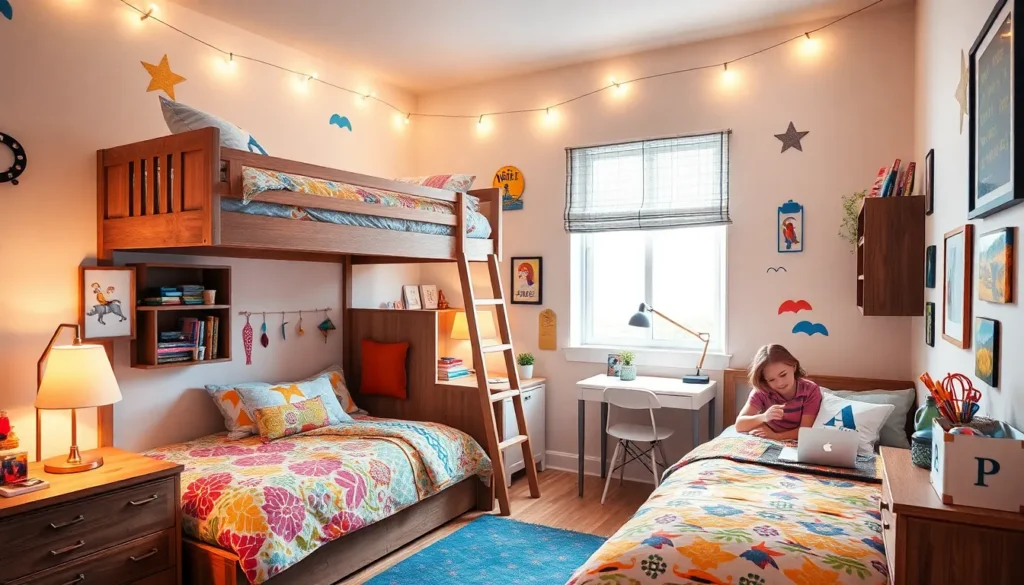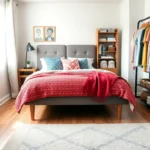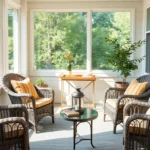Sharing a bedroom doesn’t mean sacrificing style or personal space. Whether you’re dealing with siblings who need their own zones or roommates looking to maximize a small apartment, we’ve discovered that smart design choices can transform any shared space into a functional haven that works for everyone.
We know the challenges of creating harmony in a shared bedroom – from storage struggles to privacy concerns. The good news? There are countless creative answers that’ll help you divide space effectively while maintaining a cohesive look that both occupants will love.
From clever room dividers to space-saving furniture hacks, we’re sharing the most innovative shared bedroom ideas that maximize both function and style. These proven strategies will help you create distinct personal areas without very costly or requiring major renovations.
Maximize Space With Clever Storage Solutions
Storage challenges multiply when two people share the same bedroom. We’ll explore practical answers that help you organize belongings efficiently while maintaining a clutter-free environment.
Under-Bed Storage Containers and Drawers
Under-bed storage containers transform wasted space into valuable organizational real estate. Rolling storage bins fit perfectly beneath most bed frames and provide easy access to seasonal clothing, extra bedding, or personal items. Drawer systems that slide out smoothly work exceptionally well for frequently accessed belongings like pajamas, undergarments, or school supplies.
Vacuum-sealed bags maximize under-bed capacity by compressing bulky items like comforters, winter coats, or out-of-season clothing. Clear plastic containers allow quick identification of contents without opening each box. Built-in bed drawers offer the most seamless solution, especially in platform beds or captain’s beds designed specifically for shared spaces.
Wall-Mounted Shelving and Floating Nightstands
Wall-mounted shelving creates vertical storage without consuming precious floor space. Floating shelves above each bed provide personal display areas for books, decorations, or charging stations. Corner shelves use often-overlooked spaces for storing alarm clocks, water bottles, or small personal items.
Floating nightstands eliminate the need for bulky bedside tables while still offering essential storage. These space-saving alternatives attach directly to the wall and can include small drawers or open compartments. Wall-mounted cubbies work perfectly for organizing school supplies, electronics, or hobby materials while keeping surfaces clear.
Multi-Purpose Furniture Like Storage Ottomans
Multi-purpose furniture serves double duty in shared bedrooms where every square foot matters. Storage ottomans provide comfortable seating while hiding blankets, games, or personal belongings inside. Bench seating at the foot of beds offers both storage capacity and a convenient place to sit while getting dressed.
Desk chairs with built-in storage compartments keep school supplies organized and easily accessible. Storage headboards feature shelving or cubbies for books, glasses, or small personal items within arm’s reach. Folding storage cubes can be tucked away when not needed and pulled out to provide temporary seating or storage for toys, create supplies, or sports equipment.
Create Privacy With Room Dividers and Partitions
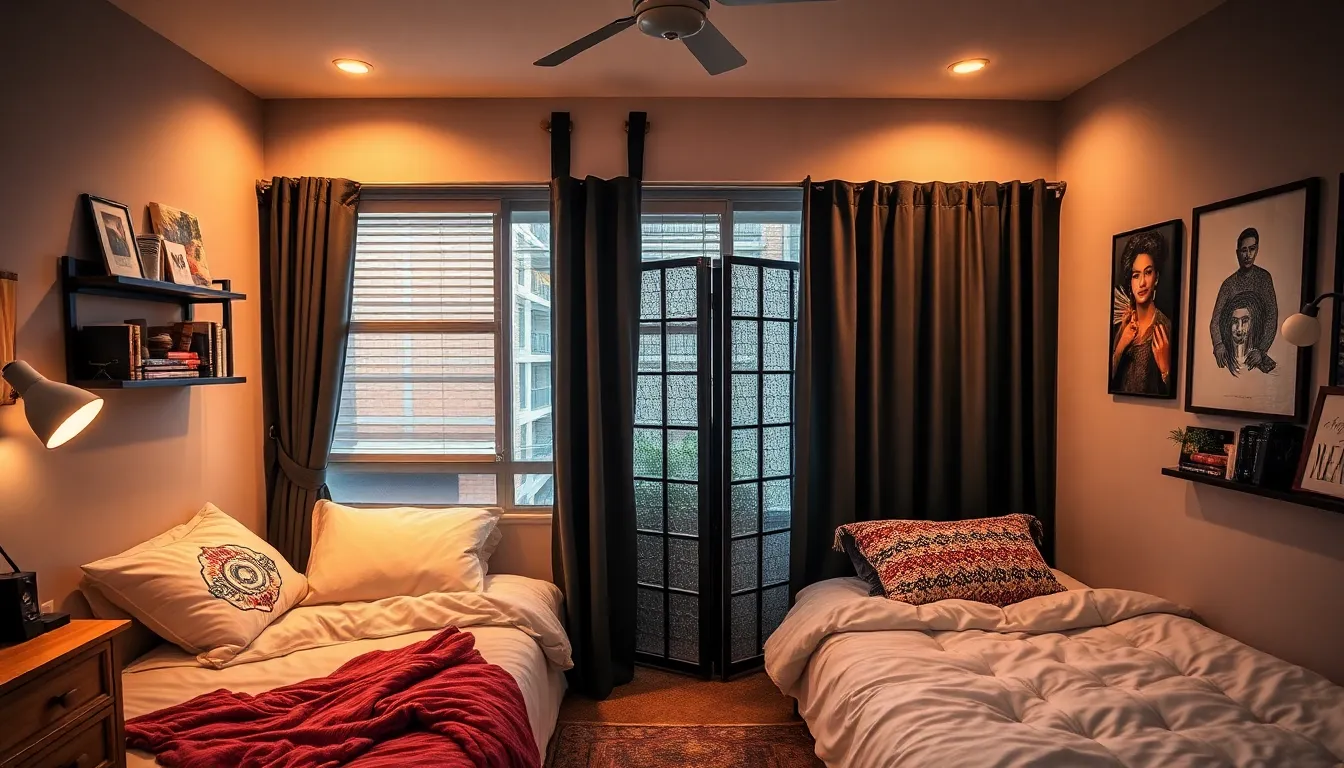
Establishing personal zones in shared bedrooms becomes effortless when we carry out strategic divider answers. Physical barriers transform open spaces into distinct areas while maintaining the room’s overall flow and functionality.
Curtain Dividers for Flexible Separation
Curtain dividers offer unmatched versatility for creating temporary privacy in shared sleeping spaces. We can install ceiling-mounted tracks that allow curtains to slide smoothly across the room, providing instant separation when needed. Heavyweight fabrics like canvas or linen work best for blocking light and sound between sleeping areas.
Mounting options include tension rods for renters or permanent ceiling tracks for homeowners who want a polished look. The beauty of curtain dividers lies in their adaptability – we can pull them back completely during the day to create an open, shared space for activities. Different curtain styles work for various room aesthetics, from sheer panels for subtle separation to blackout curtains for complete privacy.
Bookshelf Room Dividers With Dual Functionality
Bookshelf dividers maximize our shared bedroom’s potential by combining privacy with essential storage space. Open-back bookshelves work particularly well because they allow light to filter through while creating distinct zones on each side. We can arrange books, decorative items, and personal belongings to reflect each person’s individual style.
Strategic placement of these dividers creates natural pathways through the room without blocking access to windows or doors. Cube organizers and ladder-style shelving units offer modern alternatives to traditional bookcases. Storage baskets and bins can be incorporated into the shelving system to hide clutter while maintaining the clean, organized appearance that makes shared spaces more livable.
Folding Screens for Temporary Privacy
Folding screens provide instant privacy answers that we can easily relocate throughout the room as needs change. Three-panel and four-panel screens offer different coverage options depending on our space requirements. Lightweight materials like fabric or paper screens work well for temporary separation, while wooden screens add substantial visual weight and sound dampening.
Decorative screens serve double duty by adding artistic elements to the bedroom while creating functional barriers. We can position screens around dressing areas, study corners, or sleeping zones to establish personal boundaries. The portability of folding screens makes them ideal for shared bedrooms where privacy needs vary throughout the day, allowing us to quickly reconfigure the space for different activities.
Design Individual Zones for Each Person

Creating distinct personal areas within a shared bedroom transforms the space into a functional sanctuary where each person can thrive. We’ll show you how to establish these individual zones without sacrificing the room’s overall harmony.
Designated Study Areas With Personal Desks
Designated study areas with personal desks become the cornerstone of productive shared bedrooms. Each child benefits from having their own dedicated workspace customized to their exact needs and learning style. We recommend positioning desks in opposite corners or along different walls to create natural separation between study zones.
Personal desks should include built-in storage for supplies like pencils, notebooks, and textbooks to maintain organization. Comfortable seating areas paired with each desk encourage longer study sessions and better focus. We suggest choosing desks with different heights or styles to reflect each child’s personality while maintaining the room’s cohesive design.
Storage compartments within or around each desk help keep school materials organized and easily accessible. Rolling carts can serve as mobile supply stations that move between desks when needed. We find that giving each child ownership of their desk space increases their responsibility for keeping it clean and organized.
Separate Clothing Storage Systems
Separate clothing storage systems eliminate morning chaos and teach valuable organizational skills. Each child deserves their own dresser or designated closet section to store their belongings without confusion or conflict. We recommend using different colored hangers or labels to distinguish between each person’s items.
Individual storage answers can include standalone wardrobes when closet space is limited. Dresser drawers should be clearly divided with organizers to maximize space and maintain order. We suggest assigning exact shelves or hanging rods to each child to prevent clothes from getting mixed up.
Under-bed storage containers work perfectly for seasonal clothing or extra linens that each child might need. Color-coded storage bins help younger children identify their belongings quickly and independently. We find that having separate laundry baskets for each child streamlines the washing and sorting process significantly.
Individual Lighting for Reading and Tasks
Individual lighting answers allow each child to control their illumination needs without disturbing their roommate. Personal table lamps or floor lamps provide focused task lighting for assignments and reading activities. We recommend adjustable desk lamps that can direct light exactly where it’s needed most.
Reading lights attached to bed frames or headboards create cozy spaces for nighttime reading without keeping others awake. Each lighting fixture should have its own switch or dimmer to give children complete control over their personal lighting environment. We suggest choosing LED bulbs that produce less heat and consume less energy than traditional options.
Wall-mounted sconces save valuable desk and nightstand space while providing adequate task lighting. Flexible gooseneck lamps work particularly well because they can be repositioned as needed throughout the day. We find that having multiple light sources in each zone creates a more comfortable and functional personal space.
Choose a Cohesive Color Scheme That Works for Both

Creating a harmonious color palette establishes the foundation for a successful shared bedroom design. We’ll explore practical approaches that balance unity with individual expression.
Neutral Base Colors With Personal Accent Pieces
Neutral colors like beige, gray, or white serve as the perfect canvas for shared bedroom designs. These calming base tones create a peaceful atmosphere that works well for both children while providing flexibility for future updates.
Personal accent pieces allow each child to express their individuality within the cohesive framework. We recommend assigning exact color palettes to each child’s designated area through pillows, artwork, or small decorative items.
Strategic placement of these accent colors maintains visual harmony throughout the room. Each child can choose their favorite hues for their bedside accessories, desk supplies, or wall decorations while keeping the overall aesthetic balanced.
Two-Tone Paint Ideas for Visual Balance
Two-tone painting techniques create visual interest without overwhelming the shared space. We suggest painting one accent wall in a complementary color to establish a focal point that both children can enjoy.
Horizontal color division offers another effective approach to two-tone design. Paint the lower half of the walls in a deeper shade and the upper portion in a lighter tone to create visual height and dimension.
Vertical color blocking works particularly well when dividing the room between two children. Each side can feature their preferred color while maintaining the same neutral base throughout the ceiling and trim areas.
Coordinating Bedding in Complementary Patterns
Complementary patterns add visual texture without creating overwhelming chaos in shared bedrooms. We recommend selecting bedding designs that share common color elements while featuring different patterns like stripes, polka dots, or geometric shapes.
Pattern coordination extends beyond just bedspreads to include pillowcases, throw blankets, and decorative cushions. Choose designs that complement each other rather than match exactly to maintain individual personality within the cohesive scheme.
Scale variation in patterns prevents visual competition between the two sleeping areas. Pair larger geometric patterns with smaller prints or solid colors to create a balanced and sophisticated look that appeals to both room occupants.
Incorporate Smart Lighting Solutions
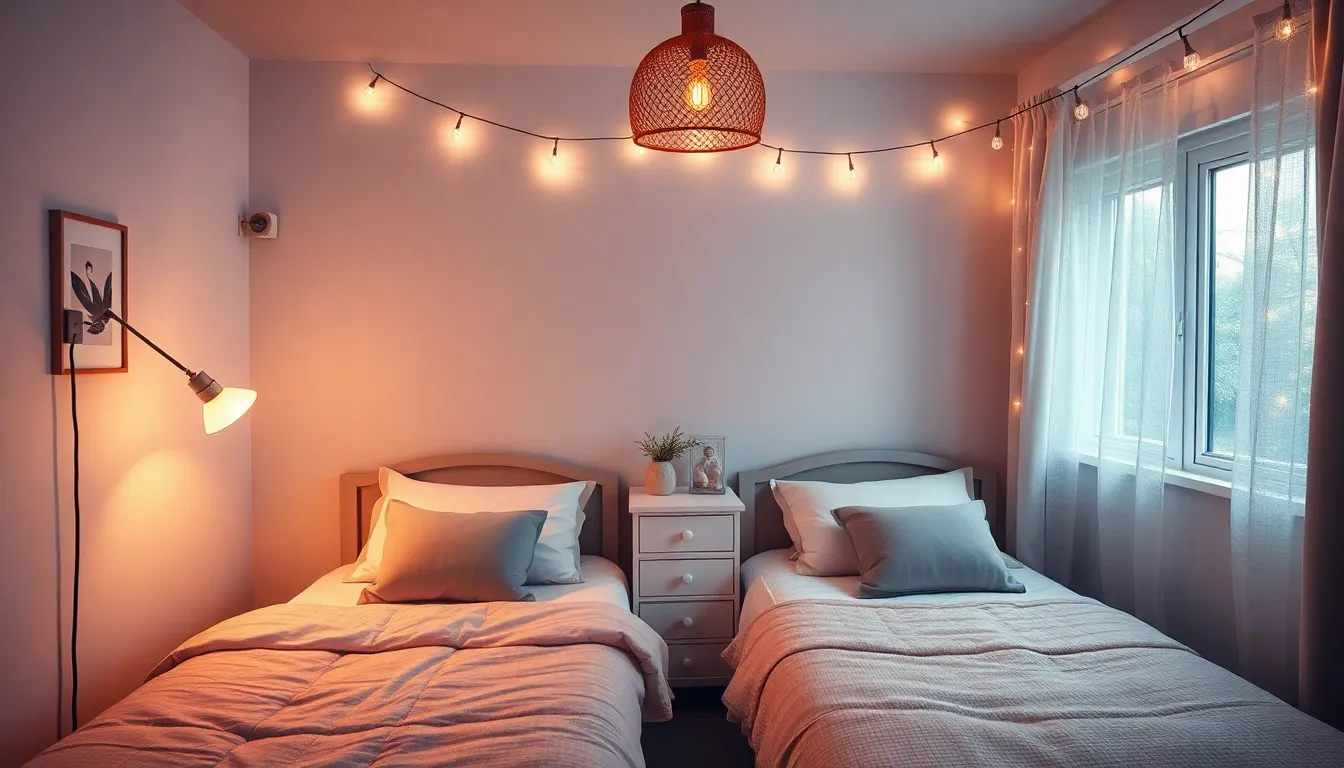
We can transform a shared bedroom into a functional and comfortable space by implementing smart lighting technology that adapts to each person’s needs. Strategic lighting placement creates individual zones while maintaining the room’s cohesive design.
Task Lighting for Individual Activities
Flexible sconces provide the perfect solution for individual reading and studying needs without disturbing a roommate. Swing-arm sconces can be directed at exact beds or desk areas, allowing each person to adjust their lighting angle for optimal visibility. Wall-mounted sconces with pull-chains offer independent control, letting each child turn their personal light on or off as needed.
Adjustable desk lamps create focused work areas for assignments and creative projects. Position individual table lamps on each person’s desk or nightstand to establish dedicated task lighting zones. These portable answers can be moved as needed while providing concentrated illumination for detailed activities.
Reading lights attached to bed frames or headboards ensure comfortable nighttime reading without affecting a sleeping roommate. Clip-on LED lights or mounted reading sconces give each person control over their personal lighting while maintaining the room’s overall aesthetic.
Ambient Lighting to Set the Mood
Pendant lights create a warm, inviting atmosphere that enhances the shared bedroom’s overall ambiance. Choose fixtures that complement your room’s color scheme and design style, positioning them to provide general illumination without creating harsh shadows. These ceiling-mounted options add visual interest while delivering functional lighting.
Chandeliers serve as statement pieces that elevate the room’s design while providing comprehensive ambient lighting. Select fixtures scaled appropriately for your room size, ensuring they complement rather than overwhelm the space. Modern chandelier designs can enhance both traditional and contemporary bedroom aesthetics.
String lights offer versatile mood lighting that can be customized for each person’s preferences. Drape LED string lights around bed frames, bulletin boards, or ceiling perimeters to create a cozy atmosphere. These affordable options provide soft illumination perfect for relaxation and socializing.
Night Lights That Won’t Disturb Sleep
Dim red lights preserve natural sleep patterns while providing necessary visibility during nighttime navigation. Install red-tinted night lights or smart bulbs that can switch to red mode, as this color spectrum doesn’t interfere with melatonin production like bright white lights do.
Smart night lights automatically adjust brightness based on time of day and room occupancy, ensuring optimal lighting conditions throughout the night. These motion-activated fixtures provide just enough illumination for safe movement while maintaining the dark environment necessary for quality sleep.
Individual nightstand lights with adjustable brightness settings allow each person to control their bedside illumination independently. Choose dimmable options that can be set to the lowest comfortable setting, providing personal lighting without disturbing a roommate’s sleep cycle.
Select Space-Saving Furniture Options

Choosing the right furniture transforms a cramped shared bedroom into a functional living space that maximizes every square foot. We’ll explore strategic furniture selections that create more room for activities while providing essential storage and sleeping accommodations.
Bunk Beds and Loft Bed Configurations
Bunk beds use vertical space effectively by stacking sleeping areas and freeing up valuable floor space for play or study zones. We recommend models with built-in storage drawers or shelves that eliminate the need for additional furniture pieces. Asymmetric bunk beds with larger bottom bunks accommodate guests or siblings who prefer more spacious sleeping arrangements.
Loft beds elevate the sleeping area to create functional space underneath for desks, reading nooks, or entertainment areas. Integrated desk units below loft beds optimize floor usage while providing dedicated study spaces. We suggest positioning these configurations in corners to maximize the remaining open floor area for shared activities.
Under-bed storage enhances both bunk and loft bed functionality through drawers or trundles that slide out for easy access. Built-in ladder storage on bunk beds provides additional organization for books, toys, or personal items without consuming extra space.
Trundle Beds for Extra Sleeping Space
Trundle beds provide flexible sleeping arrangements by pulling out from under the main bed when needed for sleepovers or visiting relatives. We find these particularly useful in shared bedrooms where occasional third occupants require accommodation. Standard twin trundles fit seamlessly under most beds and store completely out of sight during daily use.
Daybed configurations with trundles serve dual purposes as comfortable seating during the day and extra sleeping space at night. Pop-up trundles that adjust to the same height as the main bed create king-sized sleeping surfaces for special occasions. We recommend choosing trundles with casters for smooth operation and easy setup.
Compact Dressers and Wardrobes
Compact dressers fit snugly into corners or against walls without encroaching on central floor space that children need for activities. We suggest tall, narrow designs that maximize vertical storage capacity while maintaining a small footprint. Built-in dividers within drawers help organize different types of clothing efficiently.
Corner wardrobes use often-wasted corner space for hanging clothes and storing shoes or accessories. Sliding door wardrobes work better than hinged doors in tight spaces since they don’t require clearance for opening. We recommend wardrobes with adjustable shelving that adapts to changing storage needs as children grow.
Wall-mounted storage includes floating shelves and cubbies that keep essentials within reach without occupying floor space. Built-in storage benches provide seating while hiding toys, games, or seasonal items inside. These multifunctional pieces reduce clutter while serving multiple purposes in space-conscious environments.
Establish Ground Rules and Personal Boundaries

Creating clear expectations from the start prevents conflicts and ensures everyone feels respected in their shared space. We’ve found that establishing these boundaries early helps roommates navigate daily situations with confidence and consideration.
Sleep Schedule Coordination
Coordinating bedtimes becomes essential when roommates have different natural rhythms or daily schedules. We recommend discussing preferred sleep and wake times during the first week of sharing to identify potential conflicts. Some roommates prefer early bedtimes around 9 PM while others stay up past 11 PM, making compromise necessary for peaceful coexistence.
Agreeing on quiet hours helps accommodate these different patterns effectively. We suggest establishing exact time frames when noise should be minimal, such as after 10 PM on weeknights and 11 PM on weekends. Night lights provide gentle illumination for late arrivals without disturbing sleeping roommates, while noise machines can mask unavoidable sounds from movement or breathing.
Noise Level Agreements
Noise management requires ongoing communication and mutual respect between roommates sharing the same space. We’ve discovered that discussing acceptable volume levels for different activities prevents most sound related disputes. Music should be played through headphones after agreed upon hours, typically 9 PM on school nights and 10 PM on weekends.
Establishing exact guidelines for phone calls and video chats protects everyone’s privacy and concentration. We recommend taking longer conversations outside the bedroom or using earbuds to minimize disruption. Footsteps and drawer closing become important issues in shared spaces, so moving quietly during early morning and late evening hours shows consideration for sleeping roommates.
Personal Item Storage Guidelines
Dedicated storage spaces eliminate confusion about belongings and reduce potential conflicts over missing items. We suggest assigning exact areas like separate dresser drawers, labeled storage bins, or individual closet sections to each roommate. Color coded systems work particularly well, with each person choosing a exact color for their storage containers and labels.
Creating clear borrowing policies prevents disagreements about shared or personal items. We recommend establishing rules about asking permission before using someone else’s belongings, especially clothing, electronics, or school supplies. Under bed storage containers maximize available space while keeping personal items organized and easily accessible. Wall mounted shelves provide additional storage without taking up valuable floor space, allowing each roommate to display personal items and keep frequently used belongings within reach.
Add Personal Touches Without Overwhelming the Space
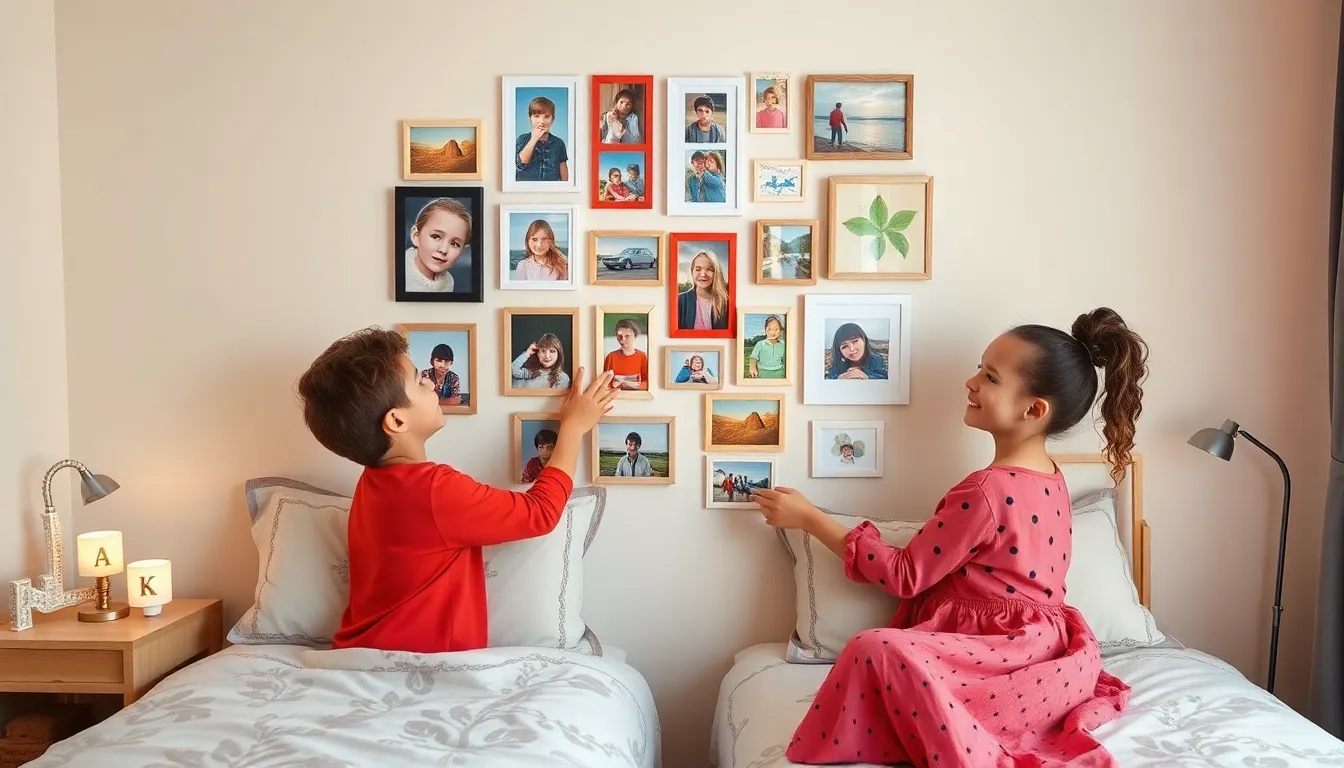
Creating meaningful personalization in a shared bedroom requires thoughtful balance between individual expression and visual harmony.
Gallery Walls With Individual Photo Collections
Gallery walls transform blank spaces into meaningful displays that celebrate both roommates’ memories and achievements. Creating a shared theme works well when both children can relate to common experiences like family vacations, holidays, or school activities. We recommend dividing the wall into distinct sections where each child showcases their personal photos, artwork, and cherished mementos.
Individual sections give each roommate ownership over their display area while maintaining visual cohesion. Position these sections side by side or create upper and lower divisions to establish clear boundaries. Collaborative displays encourage teamwork as both kids contribute to the overall arrangement and photo selection process.
Frame coordination maintains visual unity even when displaying different content. Select matching frames in neutral colors like white, black, or natural wood to create consistency across varied photo collections. Mixed frame sizes add visual interest while keeping the overall aesthetic balanced and organized.
Personalized Bedside Accessories
Monogrammed bedding creates instant personalization without overwhelming the shared aesthetic. Choose coordinating colors or patterns that complement your established color scheme while featuring each child’s initials or name. This approach ensures individual identity while maintaining bedroom harmony.
Customized nightlights serve both functional and decorative purposes in shared spaces. Select designs that match each child’s favorite characters, colors, or interests while providing adequate illumination for nighttime needs. Adjustable brightness settings prevent sleep disruption for roommates with different schedules.
Personalized storage bins keep individual belongings organized while adding decorative elements. Label containers with names, photos, or symbols that each child can easily identify. We suggest placing these bins on nightstands, under beds, or on dedicated shelves to maintain accessibility and organization.
Shared Decorative Elements That Reflect Both Personalities
Common interests create natural starting points for shared decorative themes. Incorporate elements that both children enjoy, such as sports equipment displays, animal artwork, or musical instruments that serve as functional decor. These shared passions become conversation starters and bonding opportunities.
Neutral backgrounds allow individual personalities to shine through carefully selected accent pieces. Paint walls in calming colors like soft gray, warm beige, or classic white to create a versatile canvas. Add personality through colorful artwork, throw pillows, and decorative accessories that can easily change as interests evolve.
Cooperative design processes ensure both children feel heard and valued in their shared space. Hold family design meetings where both kids contribute ideas, vote on color schemes, and compromise on decorative elements. This collaborative approach creates investment in the final result and reduces future conflicts over room aesthetics.
Conclusion
Creating a functional and stylish shared bedroom doesn’t have to be overwhelming. With the right combination of smart furniture choices strategic lighting and thoughtful organization we can transform any cramped space into a comfortable sanctuary for multiple occupants.
Remember that successful bedroom sharing relies heavily on open communication and mutual respect. When we establish clear boundaries and involve everyone in the design process we’re setting the foundation for a harmonious living arrangement that works for years to come.
The key is finding that perfect balance between individual expression and cohesive design. By implementing these practical answers we can create a space where everyone feels at home while maximizing every square foot of available room.
Frequently Asked Questions
How can I create privacy in a shared bedroom without major renovations?
Use room dividers like curtain panels, bookshelf dividers, or folding screens to create separate zones. These solutions are portable, affordable, and don’t require permanent changes. Position furniture strategically to naturally divide the space, and consider hanging curtains from the ceiling to create flexible privacy when needed.
What are the best storage solutions for a shared bedroom?
Maximize vertical space with wall-mounted shelving and floating nightstands. Use under-bed storage containers and vacuum-sealed bags for seasonal items. Invest in multi-purpose furniture like storage ottomans and desk chairs with built-in compartments. Color-coded storage systems help each person organize their belongings efficiently.
How do I choose a color scheme that works for both roommates?
Start with neutral base colors like beige, gray, or white as your foundation. Allow each person to add personal accent pieces in their preferred colors. Consider two-tone painting techniques with horizontal or vertical color divisions. Coordinate bedding in complementary patterns to maintain visual harmony while expressing individual style.
What lighting options work best in shared bedrooms?
Install flexible lighting solutions that allow individual control. Use adjustable sconces, desk lamps, and bed-mounted reading lights for personal task lighting. Add ambient lighting with pendant lights or string lights for overall atmosphere. Choose dim red night lights that won’t disturb sleep patterns.
Are bunk beds the only space-saving furniture option?
No, there are many alternatives. Loft beds create functional spaces underneath for desks or play areas. Trundle beds offer flexible sleeping arrangements. Consider compact corner wardrobes, wall-mounted storage benches, and floating shelves. These options maximize floor space while providing essential storage and functionality.
How can we establish ground rules for sharing a bedroom?
Coordinate sleep schedules and establish quiet hours that respect different routines. Set clear guidelines for personal item storage and borrowing policies. Use color-coded organization systems to prevent mix-ups. Maintain open communication about noise levels and space usage to ensure mutual respect and harmony.
Can we add personal touches without making the room look chaotic?
Yes, create individual gallery walls for personal photos while maintaining a cohesive theme. Use personalized bedside accessories like monogrammed bedding or custom nightlights. Choose shared decorative elements that reflect both personalities. Involve both roommates in the design process to ensure everyone feels represented in the space.

